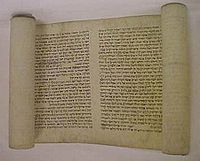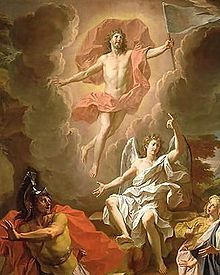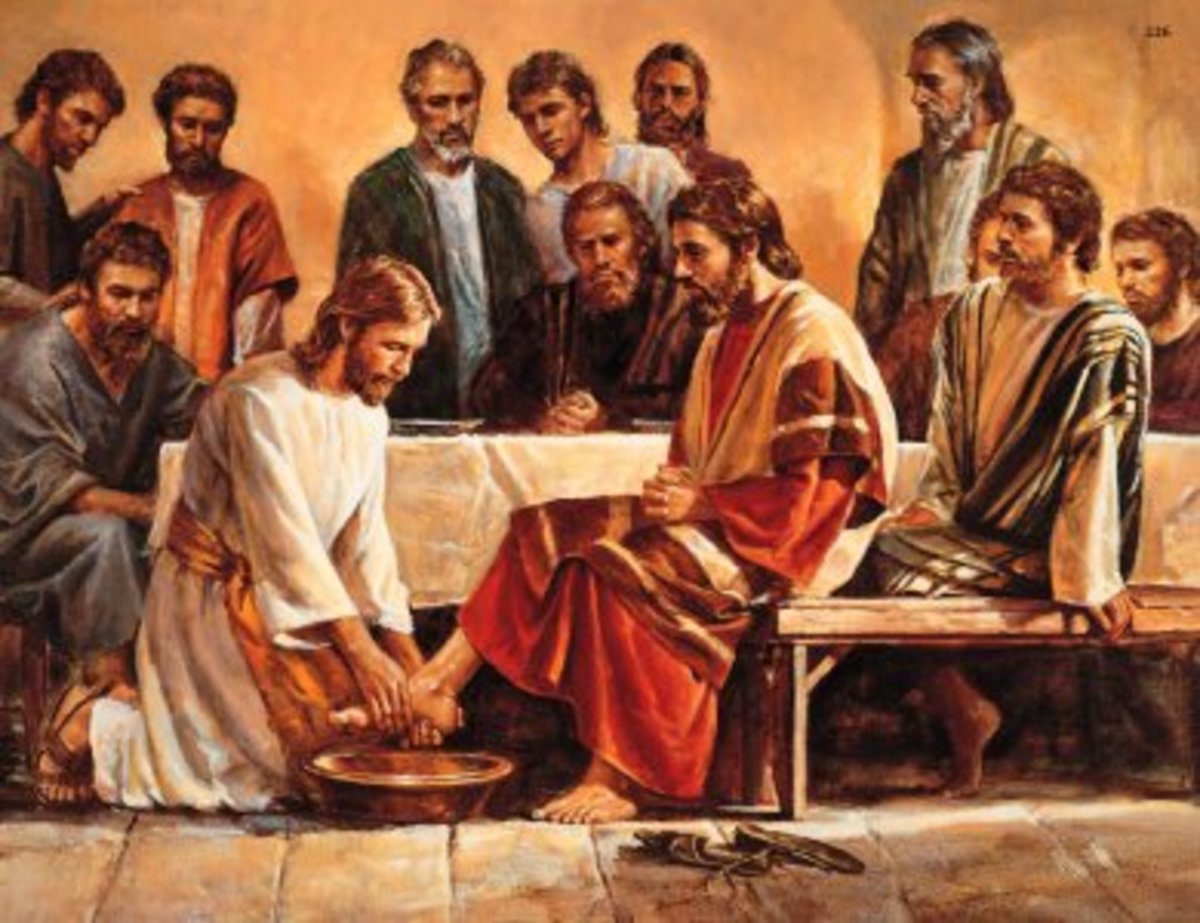Bible: What Does Acts 13 Teach Us About Paul's First "Missionary" Journey?
The Apostle Paul

Barnabas

Acts 13: Paul's First "Missionary" Journey
Prophets and Teachers in Antioch
This chapter begins a detailed account of the early and middle “Acts of Paul.” Luke first identifies some of the prophets and teachers who worked with Saul in the church at Antioch.
Besides Barnabas, he lists Simeon (whose Latin name Niger may indicate an African heritage), the Cyrenian Lucius, and Manaen, the foster-brother of Herod Antipas, the ruler of Galilee during Jesus’ ministry (v. 1; see Ryrie [New Testament Study Bible, 230]).
Saul and Barnabas Selected
While this “missions committee” is engaged in prayer and fasting, the Holy Spirit reveals His will that this local church (represented by these men) set apart Saul and Barnabas for a special ministry (v. 2).
[Apparently, the Spirit spoke audibly to this assembled group at this crucial time in Church history] .
After completing more of the same spiritual activity, they identify themselves with (“laid hands on”) the new missionaries, commissioning them and sending them on their way (v. 3).
Paul Confronts Elymas
Emphasizing that the Holy Spirit also sent out these men, Luke records the team’s first stop (via a Seleucian vessel) in their itinerary as Salamis on the island of Cyprus (vv. 4-5).
Traveling through Cyprus, Saul, Barnabas and John-Mark (Barnabas’ cousin) arrive in Paphos where they encounter two influential figures:Bar-Jesus, a Jewish false prophet/sorcerer, and Sergius Paulus, a Roman proconsul whom Luke deemed “an intelligent man,” and who wanted to hear the word of God from the apostle (vv. 6-7).
Bar-Jesus (whose Greek name is Elymas) seeks to dissuade Sergius Paulus from this course of action, raising Saul’s (now Paul’s) ire (vv. 8-9a).
While under the Spirit’s control, Paul first addresses Elymas with a three-fold indictment—the sorcerer, he says, is
(1) full of all deceit and fraud;
(2) a son of the devil; and
(3) an enemy of all righteousness—and then asks him rhetorically if he will ever stop making straight things crooked (vv. 9b-10).
[Are all unsaved people “children of the devil,” or only those who actively oppose “righteousness”? (See John 8:44; Ephesians 2:2-3]
From that point, the apostle pronounces God’s retribution—“the hand of the Lord”—upon him: temporary blindness (v. 11a)—, a punishment that transpires immediately, appearing as a dark mist that obscures his vision (v. 11b).
After witnessing the Lord’s miraculous power and justice through Paul’s teaching ministry, Sergius Paulus puts his trust in Christ (v. 12).
Paul Addresses a Synagogue in Antioch of Phyrgia
From Paphos on the island of Cyprus, the apostolic team travels to Perga, a coastal town in the region of Pamphylia; John Mark, however, voluntarily ends his mission internship for some unspecified reason and returns to Jerusalem (v. 13; cf. 2 Tim. 4:11).
Ending a brief stay in Perga, the apostle next heads north to Antioch in Phyrgia—a town “near the border of Pisidia” (231)—where he and the others attend a Sabbath-day synagogue service (v. 14).
As a common courtesy to visiting rabbis, the synagogue’s rulers invite Paul to encourage the assembly after reading from “the Law and the Prophets.”
Addressing both Jews and proselytes (“you who fear God”), the apostle delivers what became a rather lengthy message that included a synopsis of major events in Israel’s history (vv. 15-16).
The Scriptures

Paul's Synopsis of Israel's History
Beginning with God’s election of Israel (Genesis) and the LORD’s mighty deliverance of the nation from Egypt (Exodus) [v. 17], Paul’s account progresses quickly through various other historical events.
He includes their thirty-eight year stint in the wilderness (Numbers) [v. 18] and the dispersion of dispossessed land (inheritance) to the twelve tribes (Patriarchs to Judges) [v. 19].
[The NASB links the four hundred fifty years with the patriarchal period, but the NKJV connects this time with the period of the Judges until the administration of Samuel (v. 20)].
Paul follows that account with the forty-year reign of the Benjamite Saul, a king whom the people demanded of God so that Israel would be “like all the nations” (v. 21; cf. 1 Samuel 8), the removal of Saul, and the raising up of faithful David from the loins of Jesse (v. 22; cf. 1 Sam. 13:14).
He concludes with the time God made good on His promise to bring Israel a Savior: Jesus, the descendant of David (v. 23).
Paul mentions that John the Baptizer prepared the Messiah’s way by performing his “immersion unto repentance” ministry and guiding the people away from himself and toward a greater Man than he (vv. 24-5).
In his transition toward making major statements about the Messiah, the apostle readdresses his audience as the ones to whom God’s message of salvation had come (v. 26).
His subsequent remarks indict both ordinary Jerusalemites and the Jewish leadership in Jerusalem.
Not only does he accuse them of being willfully ignorant both of Jesus’ identity and of the “voices of the Prophets”—that is to say, their message about Messiah—but also for condemning Christ (in fulfillment of this prophetic message) and for asking Pilate to kill this innocent Man on their behalf (vv. 27-28).
Paul points out an amazing irony: Jesus’ Jewish and Roman adversaries (“they”) fulfilled prophetic Scriptures by murdering Him (v. 29a).
The Bodily Resurrection of Jesus Christ

John MacArthur
Paul Stresses the Resurrection
The speaker mentions a second group—whom he also designates “they” and are undoubtedly Jesus’ disciples— who took Him down from the cross and buried Him in the new sepulcher belonging to Joseph of Arimathea, a rich man (v. 29b; cf. Is. 53:9).
God, he continues, resurrected this same Jesus from death, and the Latter then appeared several times to chosen disciples (now witnesses to the Resurrection) over a period of many days, i.e., the forty days before the Ascension (vv. 30-31).
“Glad tidings”—the death, burial, and resurrection of the Messiah—constitute the fulfillment of God’s promise to Israel; this message, Paul says, he now proclaims to the present generation (vv. 32-33a).
The apostle supports his contention with three OT quotations.
First, he interprets Psalm 2:7as Yahweh’s announcement of the Resurrection: the “begetting” of His Son (v. 33b).
Second, he prefaces his citing of Isaiah 55:3—a verse that references the “sure mercies” of David, that is, the fulfillment of the covenant that promised a Messianic King for Israel—with a statement that asserts the incorruptibility of Christ’s body (v. 34).
Finally, Paul quotes Psalm 16:8-11—a passage Peter used on the day of Pentecost to refer to the resurrected Messiah as a descendant of David, the King.
These verses (in conjunction with the Isaiah passage) prove that the incorruptible Jesus, not the corruptible David, fulfilled that aspect of the covenant by virtue of His resurrection (vv. 35-37).
The Cross

Gentiles Judging Jews? God Forbid.
view quiz statisticsHaving asserted the fulfillment of the promise in Jesus’ resurrection and supported this position with Scripture, Paul now proclaims to his audience the message of forgiveness of sins “through this Man” (v. 38).
Trusting in the merits of Christ’s finished work on the cross and His resurrection accomplishes for people what their supposed obedience to the Law never could: justification (being declared righteous) before God [v. 39].
Before finishing his mini-sermon, Paul admonishes the crowd with another OT prophetic citation: Habakkuk 1:5—a message of judgment upon those Israelites who failed to believe that God would ever use Gentiles to destroy them, the “righteous.”
In the above OT passage, Yahweh planned to use the brutal Chaldeans to chastise Israel (Judah): something deemed highly unbelievable among God's chosen people.
Here, Paul refers to the destruction of Jerusalem unless the Jews repented (vv. 40-41).
The Greek construction does not specify who went out of the synagogue.
The NKJV construes the subject of the subordinate adverbial participial clause as the Jews; the NASB supplies “Paul and Barnabas” to fill that position.
In addition, the translators of the former version take ta ethne as “the Gentiles,” while those of the latter settle for “the people” (v. 42a).
The NASB seems clearer than the NKJV.
The structure of the NASB intimates that the Gentiles or people begged the apostles to preach to them again; the entire verse in the latter version seems bent on making the point that the Jews and the Gentiles left the synagogue separately.
It appears to indicate that the Jews had to leave before the Gentiles could approach someone (presumably the apostles) to beg for a second hearing (v. 42b).
Paul and Barnabas gain not an insignificant following of “Jews and devout proselytes” whom they “persuaded” (NKJV)/”were urging” (NASB) to continue trusting in God’s grace (v. 43).
[Again, the former version suggests that the apostles actually employed logical arguments successfully, convincing their audience to persevere, as though the latter had been a group of obstinate unbelievers.
On the other hand, the latter translation indicates more of a vigorous exhortation to believers to “keep on keeping on” with no connotation of either success or failure.]
Synagogues: The Places Paul Always Visited

Paul's New Evangelical Focus
view quiz statisticsA Return Performance
"Back by popular demand," the apostle (and Barnabas) preaches one week later to a packed synagogue (v. 44).
However, after seeing the great crowd Paul attracted to hear the gospel, Jewish leaders—possibly the rulers of the synagogues (v. 15) and presumably not the same people who followed them a week earlier—allow jealousy to poison their minds, and they work feverishly to contradict, blaspheme, and oppose him (v. 45).
Apparently addressing these enemies alone, Paul informs them that God had commissioned him to preach to Jews first.
However, the Jews’ vehement antagonism to the gospel and their ironic “self-condemnation” (“you reject ‘it’ ”—i.e., the word of God, “and judge yourselves unworthy of everlasting life”) convince him that it was time to spend more time preaching to the Gentiles (v. 46).
The apostle supports this decision by citing two passages from Isaiah—verses referencing the Messiah’s ministry to Gentiles, but which Paul applies as now being mediated through the Church (v. 47; cf. Is. 42:6; 49:6).
Paul’s announcement immediately brings great joy among the Gentiles present, and those “appointed to eternal life believed” (v. 48).
[It is interesting to note that the Jews disbelieved because they judged themselves unworthy of eternal life—a decision of their own “free will”—, but the Gentiles believed because they were “appointed to eternal life”—undeniably the sovereign choice of God.]
While the gospel continues to extend God’s grace throughout Pisidian Antioch, Jewish opposition also increases, enlisting the support of governmental elites and “society” women; Paul and Barnabas soon find themselves on the outside looking in (vv. 49-50).
Before traveling east to Iconium, the banished missionaries gesture toward the Jews, renouncing any further responsibility for Antioch’s spiritual welfare (v. 51).
[Ryrie describes more fully the purpose of this gesture (233).]
Their spiritual demeanor indicates that they made the right decision (v. 52).
© 2013 glynch1








